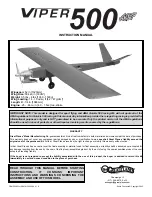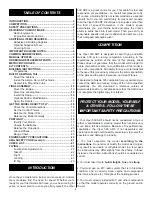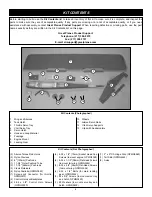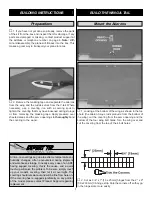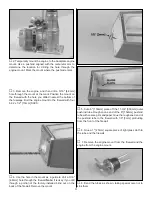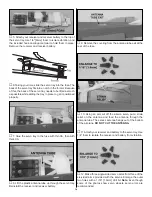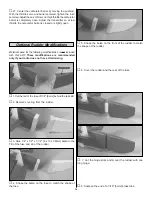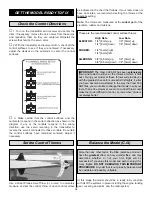
6. You must check the operation of the model before every
flight to insure that all equipment is operating and that the
model has remained structurally sound. Be sure to check
clevises or other connectors often and replace them if they
show any signs of wear or fatigue.
7. If you are not already an experienced R/C pilot, you
should fly the model only with the help of a competent,
experienced R/C pilot.
Remember: Take your time and follow the instructions
to end up with a well-built model that is straight and true.
If you have not flown this type of model before, we
recommend that you get the assistance of an experienced
pilot in your R/C club for your first flights. If you’re not a
member of a club, your local hobby shop has information
about clubs in your area whose membership includes
experienced pilots.
In addition to joining an R/C club, we strongly recommend
you join the AMA (Academy of Model Aeronautics). AMA
membership is required to fly at AMA sanctioned clubs.
There are over 2,500 AMA chartered clubs across the
country. Among other benefits, the AMA provides insurance
to its members who fly at sanctioned sites and events.
Additionally, training programs and instructors are available
at AMA club sites to help you get started the right way. Contact
the AMA at the address or toll-free phone number below:
This is a partial list of items required to finish the Viper 500
ARF that may require planning or decision-making before
starting to build. Order numbers are provided in parentheses.
❏
Receiver: standard size, minimum 4-channel.
Note: Due to the unusually high speeds and stresses
placed upon racing models such as the Viper 500 ARF,
lightweight components such as “micro” or “feather”
receivers normally intended for lightweight airplanes
(such as Park Flyers) should not be used. The Futaba
®
R148DF or R148DP receivers are suitable. Additionally,
due to the space constraints of the radio compartment,
make certain the components fit before purchasing
new gear.
❏
250mAh Lightweight receiver pack: (FUTM1210)
❏
Servo extensions: (2) 9" extensions to allow easy
connection of throttle and aileron servos (FUTM3910)
❏
Switch: Standard, with heatshrink to secure to battery
❏
Servos: (4), 3 requiring 35 oz-in of torque
❏
Servo recommendations: The Viper 500 ARF is
designed to fit a wide variety of servos. All servos may
be mid-size or standard-size servos, so long as they
provide at least 35 ounces-inch of torque. The throttle
servo may be micro through standard, so long as it
provides sufficient torque to operate your carburetor.
The recommended engine size range for the Viper 500 ARF
is .25 to .46 cu in [4.0 – 7.5cc] two-stroke. This model is not
designed for a four-stroke. As of the time of this writing, the
maximum power plant allowed for Quickie 500 racing is a
.40 [6.5cc] two-stroke, and only front-intake, side-exhaust,
commercially available, unmodified engines with stock
carburetors, utilizing approved propellers and fuels, are
permitted.
In addition to common household tools and hobby tools, this
is the “short list” of the most important items required to
build the Viper 500 ARF.
Great Planes Pro
™
CA and Epoxy
glue are recommended.
❏
1/2 oz Thin CA (GPMR6001)
❏
Drill bits: 1/16" [1.6mm], 3/16" [4.8mm], 1/4" [6.4mm]
❏
R/C foam rubber 1/4" [6mm] - (HCAQ1000)
❏
R/C foam rubber 1/2" [13mm] - (HCAQ1050)
❏
Fiberglass cloth to secure the throttle pushrod
Adhesives & Building Supplies
ADDITIONAL ITEMS REQUIRED
REMEMBER: We will not quote all of the AMA
regulations for Quickie 500 racing in this manual. Any
information regarding racing is provided for
informational purposes only and is NOT guaranteed
to be accurate. Only the printed version of the AMA
regulations should be used in case of protests or
other disputes involving events contained in the
regulations.
Engine Recommendations
Radio Equipment
DECISIONS YOU MUST MAKE
Academy of Model Aeronautics
5151 East Memorial Drive
Muncie, IN 47302
Tele: (800) 435-9262
Fax (765) 741-0057
Or via the Internet at:
http://www.modelaircraft.org
We, as the kit manufacturer, provide you with a top
quality, thoroughly tested kit and instructions, but
ultimately the quality and flyability of your finished model
depends on how you build it; therefore, we cannot in any
way guarantee the performance of your completed
model, and no representations are expressed or implied
as to the performance or safety of your completed model.
3

